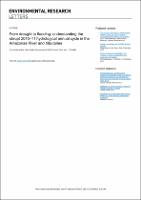Mostrar el registro sencillo del ítem
From drought to flooding: understanding the abrupt 2010-11 hydrological annual cycle in the Amazonas River and tributaries
| dc.contributor.author | Espinoza, J.C. | |
| dc.contributor.author | Ronchail, Josyane | |
| dc.contributor.author | Guyot, J.L. | |
| dc.contributor.author | Junquas, Clémentine | |
| dc.contributor.author | Guillaume, Drapeau | |
| dc.contributor.author | Martinez, Jean Michel | |
| dc.contributor.author | William, Santini | |
| dc.contributor.author | Philippe, Vauchel | |
| dc.contributor.author | Lavado-Casimiro, W. | |
| dc.contributor.author | Ordóñez Gálvez, Juan Julio | |
| dc.contributor.author | Espinoza-Villar, R. | |
| dc.coverage.spatial | Peru | |
| dc.date.accessioned | 2021-03-31T22:23:20Z | |
| dc.date.available | 2021-03-31T22:23:20Z | |
| dc.date.issued | 2012-01 | |
| dc.identifier.uri | https://hdl.handle.net/20.500.12542/861 | |
| dc.description.abstract | In this work we document and analyze the hydrological annual cycles characterized by a rapid transition between low and high flows in the Amazonas River (Peruvian Amazon) and we show how these events, which may impact vulnerable riverside residents, are related to regional climate variability. Our analysis is based on comprehensive discharge, rainfall and average suspended sediment data sets. Particular attention is paid to the 2010–11 hydrological year, when an unprecedented abrupt transition from the extreme September 2010 drought (8300 m3s−1) to one of the four highest discharges in April 2011 (49 500 m3s−1) was recorded at Tamshiyacu (Amazonas River). This unusual transition is also observed in average suspended sediments. Years with a rapid increase in discharge are characterized by negative sea surface temperature anomalies in the central equatorial Pacific during austral summer, corresponding to a La Nina-like mode. It originates a geopotential height wave train over the ˜subtropical South Pacific and southeastern South America, with a negative anomaly along the southern Amazon and the southeastern South Atlantic convergence zone region. As a consequence, the monsoon flux is retained over the Amazon and a strong convergence of humidity occurs in the Peruvian Amazon basin, favoring high rainfall and discharge. These features are also reported during the 2010–11 austral summer, when an intense La Nina event ˜ characterized the equatorial Pacific. | es_PE |
| dc.format | application/pdf | es_PE |
| dc.language.iso | eng | es_PE |
| dc.publisher | Institute of Physics Publishing | es_PE |
| dc.relation.ispartof | urn:issn:17489326 | |
| dc.relation.uri | https://iopscience-iop-org.ezproxybib.pucp.edu.pe/article/10.1088/1748-9326/7/2/024008 | es_PE |
| dc.rights | info:eu-repo/semantics/openAccess | es_PE |
| dc.rights | Atribución-NoComercial-SinDerivadas 3.0 Estados Unidos de América | * |
| dc.rights.uri | http://creativecommons.org/licenses/by-nc-nd/3.0/us/ | * |
| dc.source | Repositorio Institucional - SENAMHI | es_PE |
| dc.source | Servicio Nacional de Meteorología e Hidrología del Perú | es_PE |
| dc.subject | Amazon Basin | es_PE |
| dc.subject | ENSO | es_PE |
| dc.subject | Floods | es_PE |
| dc.subject | Amazonia | es_PE |
| dc.title | From drought to flooding: understanding the abrupt 2010-11 hydrological annual cycle in the Amazonas River and tributaries | es_PE |
| dc.type | info:eu-repo/semantics/article | es_PE |
| dc.description.peerreview | Por pares | |
| dc.identifier.doi | https://doi.org/10.1088/1748-9326/7/2/024008 | |
| dc.identifier.journal | Environmental Research Letters | |
| dc.subject.ocde | https://purl.org/pe-repo/ocde/ford#1.05.10 | es_PE |
| dc.subject.sinia | inundaciones - Clima y Eventos Naturales | |
| dc.type.sinia | text/publicacion cientifica | |
| dc.identifier.url | https://hdl.handle.net/20.500.12542/861 | |
| dc.identifier.url | https://hdl.handle.net/20.500.12542/861 |
Ficheros en el ítem
Este ítem aparece en la(s) siguiente(s) colección(es)
-
Artículo científico [171]









